
Euphorbia is a very large and diverse genus of flowering plants, commonly called spurge, in the family Euphorbiaceae. "Euphorbia" is sometimes used in ordinary English to collectively refer to all members of Euphorbiaceae, not just to members of the genus.

Dactylorhiza is a genus of flowering plants in the orchid family Orchidaceae. Its species are commonly called marsh orchids or spotted orchids. Dactylorhiza were previously classified under Orchis, which has two round tubers.

Caryophyllaceae, commonly called the pink family or carnation family, is a family of flowering plants. It is included in the dicotyledon order Caryophyllales in the APG III system, alongside 33 other families, including Amaranthaceae, Cactaceae, and Polygonaceae. It is a large family, with 81 genera and about 2,625 known species.

Cypripedioideae is a subfamily of orchids commonly known as lady's slipper orchids, lady slipper orchids or slipper orchids. Cypripedioideae includes the genera Cypripedium, Mexipedium, Paphiopedilum, Phragmipedium and Selenipedium. They are characterised by the slipper-shaped pouches of the flowers – the pouch traps insects so they are forced to climb up past the staminode, behind which they collect or deposit pollinia, thus fertilizing the flower. There are approximately 165 species in the subfamily.

Gypsophila is a genus of flowering plants in the carnation family, Caryophyllaceae. They are native to Eurasia, Africa, Australia, and the Pacific Islands. Turkey has a particularly high diversity of Gypsophila taxa, with about 35 endemic species. Some Gypsophila are introduced species in other regions.
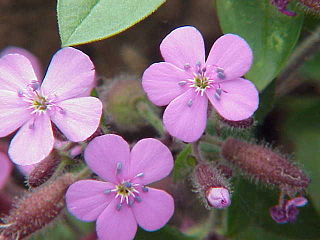
Saponaria is a genus of flowering plants in the family Caryophyllaceae, native to Asia and Europe, and are commonly known as soapworts. They are herbaceous perennials and annuals, some with woody bases. The flowers are abundant, five-petalled and usually in shades of pink or white. The genus is closely related to the genus Silene, being distinguished from these by having only two styles in the flower. It is also related to Gypsophila, but its calyx is cylindrical rather than bell-shaped.

Phrymaceae, also known as the lopseed family, is a small family of flowering plants in the order Lamiales. It has a nearly cosmopolitan distribution, but is concentrated in two centers of diversity, one in Australia, the other in western North America. Members of this family occur in diverse habitats, including deserts, river banks and mountains.

In biology, a species complex is a group of closely related organisms that are so similar in appearance and other features that the boundaries between them are often unclear. The taxa in the complex may be able to hybridize readily with each other, further blurring any distinctions. Terms that are sometimes used synonymously but have more precise meanings are cryptic species for two or more species hidden under one species name, sibling species for two species that are each other's closest relative, and species flock for a group of closely related species that live in the same habitat. As informal taxonomic ranks, species group, species aggregate, macrospecies, and superspecies are also in use.
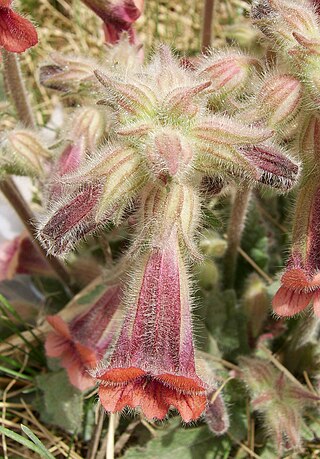
Rehmannia is a genus of seven species of flowering plants in the order Lamiales and family Orobanchaceae, endemic to China. It has been placed as the only member of the monotypic tribe Rehmannieae, but molecular phylogenetic studies suggest that it forms a clade with Triaenophora. Contrary to the immense majority of the taxa of Orobanchaceae, Rehmannia is not parasitic.

Silene dioica, known as red campion and red catchfly, is a herbaceous flowering plant in the family Caryophyllaceae, native to Europe and introduced to the Americas.

Asteliaceae is a family of flowering plants, placed in the order Asparagales of the monocots.
Pentaphylax is a genus of flowering plants, with one or two species which are shrubs and small trees. The species has simple evergreen leaves that are alternately arranged on the stems. The flower pistil is 5 celled and the anthers dehiscing via pores and basifixed. Flowers have five petals and five sepals that are distinct from each other and five stamens attached oppositely to the sepals. The seeds are winged.
Microbotryum silenes-dioicae is a species of fungus first isolated from Brittany, France. Its name refers to its host species, Silene dioica. The fungus is the cause of anther-smut disease, which results in fungal spores replacing the pollen in the anthers. The species that most resembles ‘’M. silenes-dioicae’’ morphologically is M. lychnidis-dioicae.
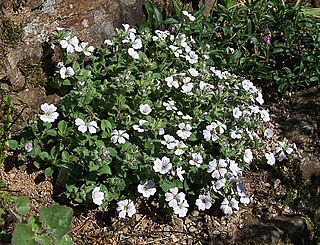
Acanthophyllum cerastioides, the chickweed baby's-breath, is a perennial plant of the family Caryophyllaceae, found in Bangladesh, Bhutan, North India, Nepal, North Pakistan, and Sikkim, with a typical height of 10–27 cm. Recent molecular studies show this species is a member of the genus Acanthophyllum rather than Gypsophila.
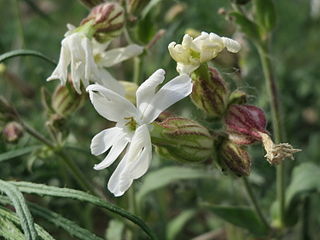
Microbotryum violaceum is a host-specific anther smut (fungus) disease that infects Silene latifolia and sterilizes the host plant. When infected with this disease, the flowers generate pathogenic spores, which can then be transferred to other plants by pollinating insects. Therefore, this disease is sometimes classified as a sexually transmitted infection.
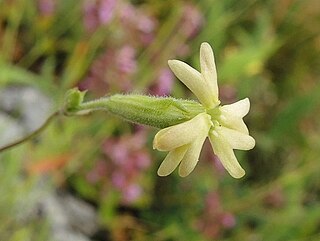
Silene flavescens are flowering plants part of the genus Silene, family Caryophyllaceae. They are widely distributed and are found in the northern hemisphere. They are native to Hungary and the Balkan Peninsula. It is an herbaceous species belonging to the tribe Sileneae

The Turkestan short-toed lark is a species of lark in the family Alaudidae. It is found in Ukraine and central Turkey through parts of Central Asia and southern Siberia west to south-central Mongolia and south to southern Afghanistan. This species and the Mediterranean short-toed lark were formerly considered conspecific and called the lesser short-toed lark, but a 2020 study recovered them as distinct species.
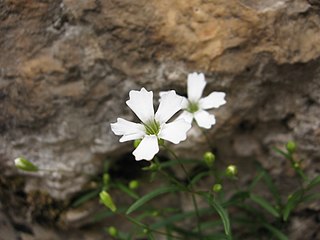
Heliosperma pusillum is a species of flowering plants in the family Caryophyllaceae. It is native to mountain ranges of Western Europe. It's a species of plants with a complex evolutionary history characterized by repeated ecological divergence.
In biology, parallel speciation is a type of speciation where there is repeated evolution of reproductively isolating traits via the same mechanisms occurring between separate yet closely related species inhabiting different environments. This leads to a circumstance where independently evolved lineages have developed reproductive isolation from their ancestral lineage, but not from other independent lineages that inhabit similar environments. In order for parallel speciation to be confirmed, there is a set of three requirements that has been established that must be met: there must be phylogenetic independence between the separate populations inhabiting similar environments to ensure that the traits responsible for reproductive isolation evolved separately, there must be reproductive isolation not only between the ancestral population and the descendent population, but also between descendent populations that inhabit dissimilar environments, and descendent populations that inhabit similar environments must not be reproductively isolated from one another. To determine if natural selection specifically is the cause of parallel speciation, a fourth requirement has been established that includes identifying and testing an adaptive mechanism, which eliminates the possibility of a genetic factor such as polyploidy being the responsible agent.















